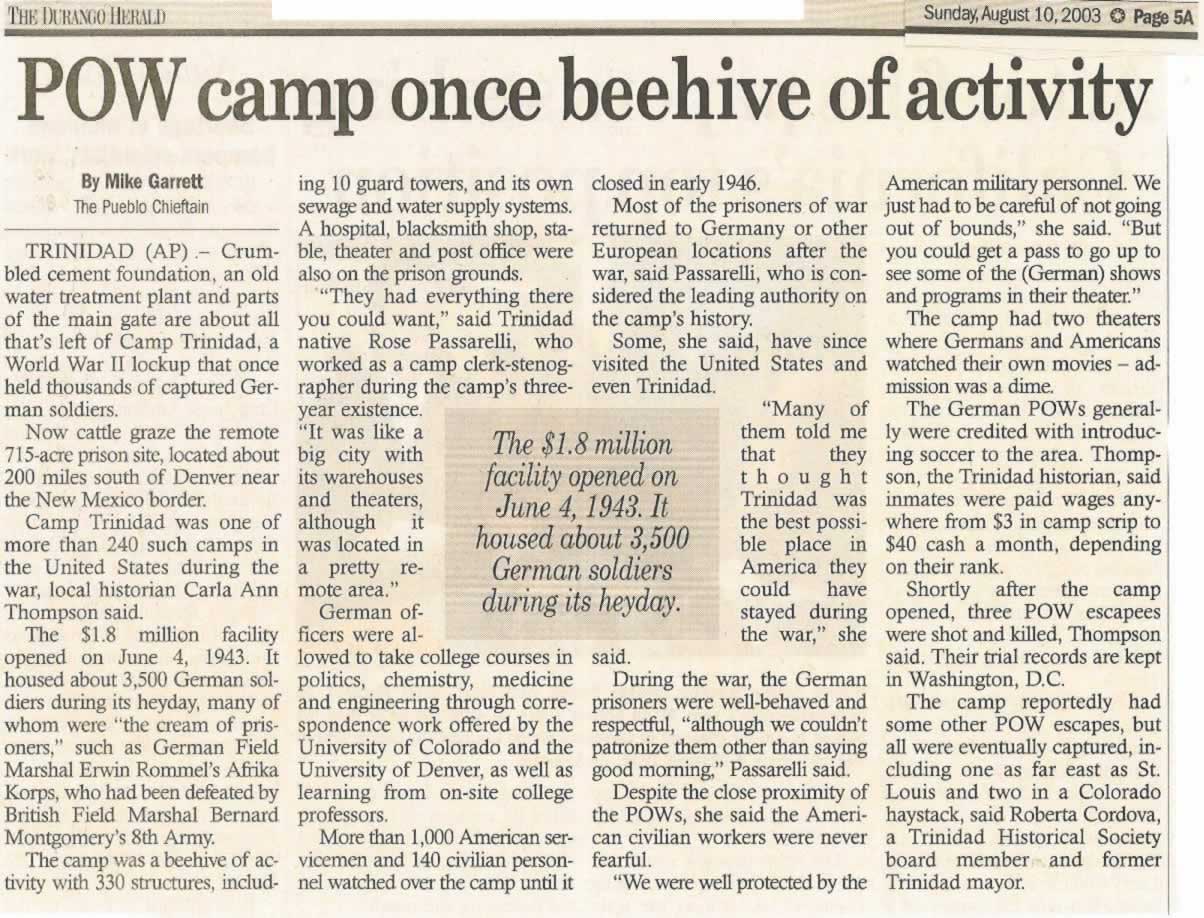|
Moderated by NW Okie! |
Volume 17 , Issue 22015Weekly eZine: (371 subscribers)Subscribe | Unsubscribe Using Desktop... |
WWII (1942-1945) POW Camps of Camp Trinidad, Colorado

This article is from The Durango Herald, Sunday, August 10, 2003, page 5A, written by Mike Garrett, concerning The Pueblo Chieftain. This Colorado POW camp was once a behive of activity during WWII.
Trinidad (AP) -- Crumbled cement foundation, an old water treatment plant and parts of the main gate are about all that's left of Camp Trinidad, a World War II lockup that once held thousands of captured German soldiers.
Now cattle graze the remote 715-acre prison site, located about 200 miles south of Denver near the New Mexico border.
Camp Trinidad was one of more than 240 such camps in the United States during the war, local historian Carla Ann Thompson said.
The $1.8 million facility opened on June 4, 1943. It housed about 3,500 German soldiers during its heyday, many of whom were "the cream of prisoners," such as German Field Marshal Erwin Rommel's Afrika Korps, who had been defeated by British Field Marshal Bernard Montgomery's 8th Army.
The camp was a beehive of activity with 330 structures, including 10 guard towers, and its own sewage and water supply systems. A hospital, blacksmith shop, stable, theater and post office were also on the prison grounds.
"They had everything there you could want," said Trinidad native Rose Passarelli, who worked as a camp clerk-stenographer during the camp's three-year existence. "It was like a big city with its warehouses and theaters, although it was located in a pretty remote area."
German officers were allowed to take college courses in politics, chemistry, medicine and engineering through correspondence work offered by the University of Colorado and the University of Denver, as well as learning from on-site college professors.
More than 1, 000 American servicemen and 140 civilian personnel watched over the camp until it closed in early 1946.
Most of the prisoners of war returned to Germany or other European locations after the war, said Passarelli, who is considered the leading authority on the camp's history.
Some, she said, have since visited the United States and even Trinidad.
"Many of them told me that they thought Trinidad was the best possible place in America they could have stayed during the war," she said.
During the war, the German prisoners were well-behaved and respectful, "although we couldn't patronize them other than saying good morning," Passarelli said.
Despite the close proximity of the POWs, she said the American civilian workers were never fearful.
"We were well protected by the American military personnel. We just had to be careful of not going out of bounds," she said. "But you could get a pass to go up to see some of the (German) shows and programs in their theater."
The camp had two theaters where Germans and Americans watched their own movies -- admission was a dime.
The German POWs generally were credited with introducing soccer to the area. Thompson, the Trinidad historian, said inmates were paid wages anywhere from $3 in camp scrip to $40 cash a month, depending on their rank.
Shortly after the camp opened, three POW escapees were shot and killed, Thompson said. Their trial records are kept in Washington, D.C.
The camp reportedly had some other POW escapes, but all were eventually captured, including one as far east as St. Louis and two in a Colorado haystack, said Roberta Cordova, a Trinidad Historical Society board member and former Trinidad mayor.
| View or Add Comments (0 Comments)
| Receive
updates ( subscribers) |
Unsubscribe
| © . Linda Mcgill Wagner - began © 1999 Contact Me | |
